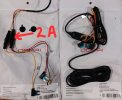Cloudy
New Member
My situation is similar to this older post but my hardwire kit has been updated. It includes an inline 2-amp cartridge fuse and a single, inbuilt two-pronged blue fuse (which I believe is 15 amp).
The wonderful Alex made a video on this type of kit but he suggested that if there isn't a spare slot in the fuse box, you should cut and replace the single blue end fuse with a fuse tap.
I contacted the manufacturer, and they said I don't need to do this because the 2A inline fuse and inbuilt blue fuse handles it.
Since I don't have a spare slot, my initial thought was to replace an existing, non-critical 15A fuse with the kit's end fuse. The kit's blue fuse would take care of the vehicle's existing electrical component of that slot, and the inline 2A fuse would protect the dash cam. Now I'm unsure if this is the right approach.
Thoughts?

I wtr
The wonderful Alex made a video on this type of kit but he suggested that if there isn't a spare slot in the fuse box, you should cut and replace the single blue end fuse with a fuse tap.
I contacted the manufacturer, and they said I don't need to do this because the 2A inline fuse and inbuilt blue fuse handles it.
Since I don't have a spare slot, my initial thought was to replace an existing, non-critical 15A fuse with the kit's end fuse. The kit's blue fuse would take care of the vehicle's existing electrical component of that slot, and the inline 2A fuse would protect the dash cam. Now I'm unsure if this is the right approach.
Thoughts?

I wtr
